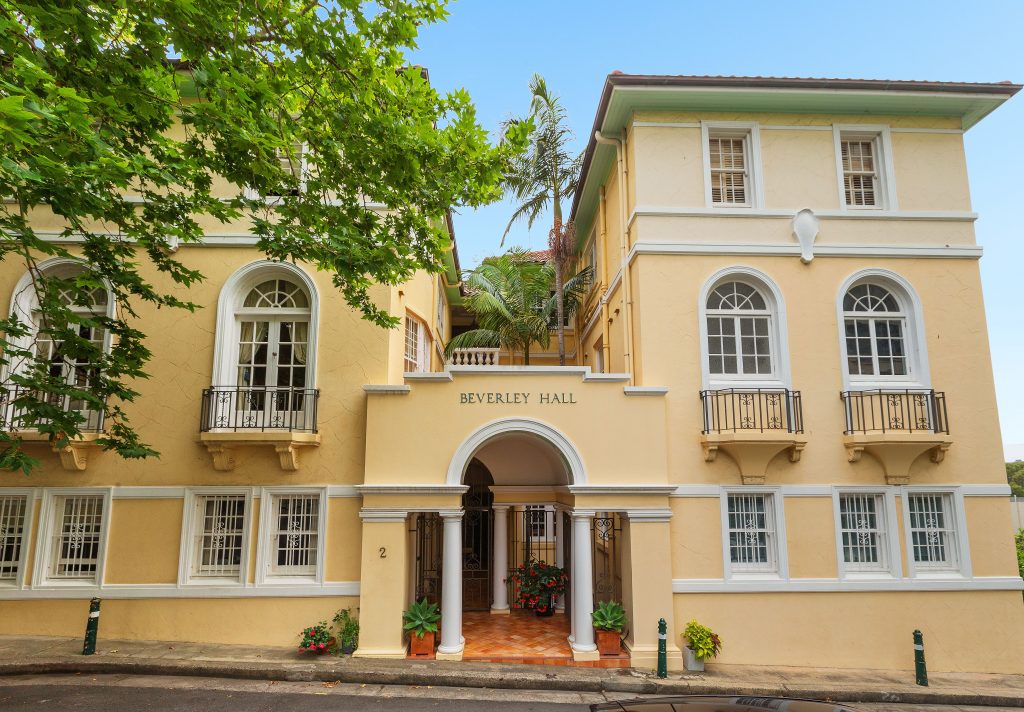2 ELIZABETH BAY CRESCENT:” ULTRA SPECIAL”

What do a judge, his dead wife, an amateur actor, water views and a no-expense-spared apartment block all have in common? They all involve 2 Elizabeth Bay Crescent.
Apartment 12, 2 Elizabeth Bay Crescent, is currently for sale through Greg McKinley, Andrew Hoggett and Penny Timothy https://www.rwebay.com.au/3966458/
This fascinating block was built in 1928 and designed by Pitt and Morrow for its owner, a wealthy barrister. Its original sales brochure noted “it is away from the noise and bustle of the city with a garden approach … an elevator renders service with softly illuminated hidden lights … so dignified – so friendly – so comfortable … it soon becomes irresistible.”
Apartments were originally rented from £5 per week up to £10, some with “3 living rooms, 4 bedrooms and 2 bathrooms”, obviously expansive and expensive considering the average weekly male wage in the 1920s was only £9-00.
The Sydney Morning Herald of September 1929 was exuberant, explaining that “here is a fine piece of modern apartment planning … combining every labour-saving device known to the building world … the quiet dignity of the Italian renaissance facade [and] main entrance … with its pure beauty of line. The exterior colour scheme has been carefully studied … the buff walls are relieved with the pale orange and green of the eaves and window frames. The water-front facade, overlooking the flagged steps winding to the swimming pool, presents glorious views of the whole of Elizabeth Bay … walls are individually treated with exclusively selected wallpapers and the electric fittings (specially imported) contribute to the atmosphere of refinement … no expense has been spared in the desire to provide an ultra-special home … with lounges overlooking the view, and a living-room, dining-room, smoke-room, entrance hall, three bedrooms and maid’s room, two bathrooms, large kitchen and scullery. Large open brick fire-places are a feature … the kitchens are tiled and enamelled with refrigerators installed.”
Many buildings of this period incorporated elements of more than one style, apart from Art Déco. The early 20th century was a buoyant period of changes and layered architecture.
Beverley Hall at number 2 is a fine example of the inter-war (1916-1938) Mediterranean Style with vaulted arches, Tuscan columns, a ‘monk’s door’ of solid, engraved cedar, a cool, shaded, tiled entrance, hand-rendered exterior walls and terracotta tiles, all reminiscent of Roman and Spanish villas which evolved in similarly hot climates.
Its original owner was a colourful character. He was a senior barrister and King’s Counsel (today known as Queen’s Counsel or QC or SC) who enjoyed a flourishing practise of defamation cases, later becoming an Acting District Court Judge. He also enjoyed a second career in music and as an amateur actor. He became embroiled in a case of his own when he found his wife dead in the bathroom at their holiday house: she had gone missing and had taken a sleeping pill overdose, apparently, although “there was nothing to indicate the manner in which Mrs Curtis had met her death”, according to detectives quoted in media. No charges were laid.
Today, Beverley Hall retains its patrician position and original style, embracing its harbour-side setting.
By Andrew Woodhouse, Heritage Solutions





